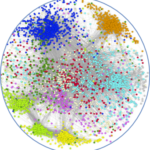Link to Pubmed [PMID] – 28883405
Link to DOI – 2510.1038/s41537-017-0027-3
NPJ Schizophr 2017 Sep; 3(1): 25
Hundreds of genetic loci participate to schizophrenia liability. It is also known that impaired cerebral connectivity is directly related to the cognitive and affective disturbances in schizophrenia. How genetic susceptibility and brain neural networks interact to specify a pathological phenotype in schizophrenia remains elusive. Imaging genetics, highlighting brain variations, has proven effective to establish links between vulnerability loci and associated clinical traits. As previous imaging genetics works in schizophrenia have essentially focused on structural DNA variants, these findings could be blurred by epigenetic mechanisms taking place during gene expression. We explored the meaningful links between genetic data from peripheral blood tissues on one hand, and regional brain reactivity to emotion task assayed by blood oxygen level-dependent functional magnetic resonance imaging on the other hand, in schizophrenia patients and matched healthy volunteers. We applied Sparse Generalized Canonical Correlation Analysis to identify joint signals between two blocks of variables: (i) the transcriptional expression of 33 candidate genes, and (ii) the blood oxygen level-dependent activity in 16 region of interest. Results suggested that peripheral transcriptional expression is related to brain imaging variations through a sequential pathway, ending with the schizophrenia phenotype. Generalization of such an approach to larger data sets should thus help in outlining the pathways involved in psychiatric illnesses such as schizophrenia.SEARCHING FOR LINKS TO AID DIAGNOSIS: Researchers explore links between the expression of genes associated with schizophrenia in blood cells and variations in brain activity during emotion processing. El Chérif Ibrahim and Eric Fakra at Aix-Marseille Université, France, and colleagues have developed a method to relate the expression levels of 33 schizophrenia susceptibility genes in blood cells and functional magnetic resonance imaging (fMRI) data obtained as individuals carry out a task that triggers emotional responses. Although they found no significant differences in the expression of genes between the 26 patients with schizophrenia and 26 healthy controls they examined, variations in activity in the superior temporal gyrus were strongly linked to schizophrenia-associated gene expression and presence of disease. Similar analyses of larger data sets will shed further light on the relationship between peripheral molecular changes and disease-related behaviors and ultimately, aid the diagnosis of neuropsychiatric disease.


